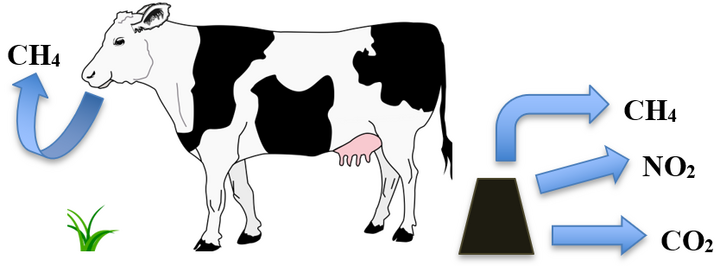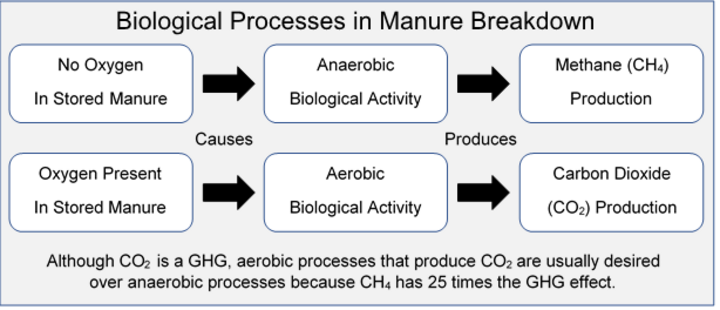Reducing Greenhouse Gas Emissions from Cattle Production
Julia Lindgren, Graduate Student in UNL's Biological Systems Engineering Department
Reducing greenhouse gas (GHG) emissions may seem like extra work that can hurt business, but in reality best management practices for reducing GHG emissions can be economical. These practices may also have other benefits such as reducing unpleasant odors. There are two main areas where producers can reduce significant amounts of greenhouse gases. Best management practices to increase production efficiency and reduce methane produced from cattle digestion of feed can be used alongside manure management techniques.
Practices to Reduce Greenhouse Gas Emissions
- Increase production through herd health and breeding practices
- Feed cattle based on nutrient needs
- Composting
- Include additives in manure to suppress unwanted biological activity
- Implement manure storage covers and anaerobic digesters
Animal Production Efficiency and Digestion Efficiency
What Are Greenhouse Gases?Greenhouse gases (or GHG) are gases that trap heat in the atmosphere. Common GHG are: carbon dioxide (CO2), methane (CH4), and nitrous oxide (N2O). Carbon dioxide is a well-known GHG. However, methane and nitrous oxide has 25 and 300 times, respectively, the GHG effect as CO2.
Improving production efficiency is key in reducing GHG emissions and is also beneficial to business. Increasing production efficiency will result in more cattle marketed and/or live weight produced while using fewer resources. Breeding, feeding, and health programs greatly affect production efficiency.
Other factors to be considered include purchasing supplies such as feed grown nearby will reduce shipping emissions.
Breeding
Breeding for herd health will reduce mortalities. Lowering mortalities means fewer emissions. Breeding for high weight, heat and disease resistant cattle will increase this efficiency.Feed Efficiency
Feeding animals to improve feed efficiency and performance has the added benefit of reducing greenhouse gas emissions. Test your forage for nutrient content and compare the results to the nutrient requirements of your cattle. Picking the correct nutrient content for your cattle (e.g. protein) will keep you from overfeeding these nutrients and therefore losing them in manure. Some feed may be suitable for a fully- grown male but not for a pregnant female in the last trimester. The animal industry has made significant strides in reducing greenhouse gas emissions by their sustained efforts to improve efficiency.
Increase Digestibility
Use of corn or legume feeds will produce less methane than grass fed cattle. However, it is important to take into account your region’s resources (e.g. it’s impractical to grow corn in many pasture areas).
Feed Additives
Feed additives can lower methane production from the cattle’s belching. Ionophores and some oils are a few examples of these additives.
Manure Management
Manure management is also an important part of the puzzle. Methane and nitrous oxide can be emitted from manure during storage or after application to cropland as fertilizer.

Composting
Composting is a low-cost method to reduce methane emissions that is relatively easy to implement. Composting makes the compounds in manure more stable and therefore reduces the amount that is released into the atmosphere. Composting works by encouraging aerobic activity and reducing anaerobic activity.
Manure Additives
During storage, manure additives can be used to suppress GHG production. These additives can aid or inhibit certain biological pathways involved with greenhouse gas production. There are many products marketed as manure additives. Many of them claim to reduce greenhouse gas emissions. Research on the effectiveness of these products has been mixed, so the claims of a manufacturer should be backed by field research. Reduction of ammonia and nitrous oxide emissions can also result in preservation of manure nutrients.
Surface Covers
Surface covers have been found to be effective technology at reducing greenhouse gas emissions from stored manure. Covers can be engineered permanent covers, engineered synthetic materials, or can be as simple as a straw or hay. Organic matter, which floats to the top of a lagoon, can also serve the purpose of a natural cover.
Manure Aeration
Aerating manure allows aerobic microbes to grow in a typically anaerobic environment. These aerobic microbes encourage breakdown of gas-producing compounds. CO2, which is a much weaker GHG, is produced instead of CH4. Ammonia and hydrogen sulfide (which cause malodor) are converted to nitrate and sulfate. This technology can be very effective but may have a large energy cost.
Anaerobic Digestors
Methane produced during anaerobic digestion of manure can be captured and used to replace fossil fuels. This methane can even be repurposed to power farm vehicles or to run a generator to create electricity. Though burning methane produces carbon dioxide, carbon credits can still be acquired through this process because of the reduction of greenhouse gas potential.
Many current practices by cattle operations to improve efficiency and performance should be recognized as also reducing GHG impacts. Additional practices such as composting may provide future options for both economic and GHG benefits.
Works Cited
Suppliers. (n.d.). Retrieved October 29, 2018, from http://gapesco.com/Suppliers.aspx
Alberta Agriculture and Forestry, Trade and Environment Division, Environmental Stewardship Branch, Environmental Strategy and Research Section, J. L., & X. L. (2015, December 09). Manure Management and Greenhouse Gases - Things You Need To Know. Retrieved October 29, 2018, from https://www1.agric.gov.ab.ca/$department/deptdocs.nsf/all/cl10038
Andersen, D. S., Harmon, J. D., Hoff, S. J., & Rieck-Hinz, A. M. (2014). Manure Storage and Handling - Aeration Overview [PDF]. Ames: Iowa State University Agriculture and Environment Extension.
Andeweg, K., & Reisinger, A. (2014). [PDF]. SIA Platform.
Ciolkosz, D., & Ndegwa, P. (2013, August 2). Introduction to Biogas and Anaerobic Digestion. Retrieved October 31, 2018, from https://articles.extension.org/pages/26608/introduction-to-biogas-and-anaerobic-digestion
Gerber, P., Hendersen, B., & Makkar, H. (2013). MITIGATION OF GREENHOUSE GAS EMISSIONS IN LIVESTOCK PRODUCTION. Retrieved October 29, 2018, from http://www.fao.org/docrep/018/i3288e/i3288e.pdf
Janni, K., & Stowell, R. (2015, January 6). Manure Storage Covers Curriculum Materials. Retrieved October 29, 2018, from https://articles.extension.org/pages/61433/manure-storage-covers-curriculum-materials
Ohio State Extention. (2014). How to Forage Test and Assess Feed Quality. Retrieved October 29, 2018, from http://www.thecattlesite.com/articles/4196/how-to-forage-test-and-assess-feed-quality/
Overview of Greenhouse Gases. (2018, October 09). Retrieved October 29, 2018, from https://www.epa.gov/ghgemissions/overview-greenhouse-gases
Reducing or Mitigating Greenhouse Gas Emissions In Animal Agriculture. (2016, September 22). Retrieved October 29, 2018, from https://articles.extension.org/pages/69144/reducing-or-mitigating-greenhouse-gas-emissions-in-animal-agriculture
Wheeler, E., Adviento-Borbe A., Brandt, R., Topper, D., Elliot H., Graves, R., Hvistov, A., Ishler, V., Bruns, M. (2011). Manure amendments for mitigation of dairy ammonia and greenhouse gas emissions: preliminary screening. Agric Eng Int: CIGR Journal, 13(2), 1-14.
This article was reviewed by Galen Erickson and Rick Stowell, faculty with UNL Animal Science and Biological Systems Engineering departments.